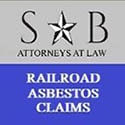
Asbestos exposure has long been a hidden danger for railroad workers, particularly those employed before the 1980s. Despite the delayed onset of symptoms, the health risks remain severe, and understanding these risks is crucial. Sammons & Berry P.C., a nationwide law firm, specializes in helping railroad workers obtain compensation for asbestos-related illnesses without the need for court appearances or litigation.
Understanding Asbestos Exposure in the Railroad Industry
For much of the 20th century, asbestos was widely used across various industries due to its heat-resistant properties, with the railroad industry being no exception. Asbestos was commonly used in locomotive brake pads, engine insulation, and construction materials in railroad facilities. Unfortunately, many workers were unaware of the health risks associated with asbestos exposure.
Common Areas of Exposure for Railroad Workers
Railroad workers were often exposed to asbestos in several ways:
- Locomotive Brake Pads: Asbestos was extensively used in brake pads due to its heat resistance. Workers involved in maintenance, especially in the mechanical department, risked inhaling asbestos fibers during repairs or replacements.
- Engine Insulation: Asbestos-containing insulation was commonly used to control the extreme heat generated by locomotive engines. Workers, including engineers, conductors, and mechanics, faced exposure to airborne asbestos fibers when this insulation was disturbed.
- Buildings and Facilities: Many railroad buildings and facilities contained asbestos in construction materials, particularly in insulation, ceiling tiles, and flooring, leading to potential exposure for workers in these environments.
The Health Risks of Asbestos Exposure
Asbestos exposure is linked to several severe health conditions, many of which develop years or even decades after initial exposure. Here’s a detailed look at the primary diseases associated with asbestos exposure:
Mesothelioma
Mesothelioma is a rare, aggressive cancer that primarily affects the lining of the lungs (pleura), abdomen (peritoneum), or heart (pericardium). This cancer is almost exclusively caused by asbestos exposure. It has an exceptionally long latency period, typically developing 20-50 years after the initial exposure, making it particularly devastating for those who worked in environments where asbestos was prevalent. The symptoms depend on the affected area but generally include chest or abdominal pain, shortness of breath, and fluid buildup.
- Pleural Mesothelioma: This is the most common form, impacting the lining of the lungs. Symptoms include persistent coughing, chest pain, and difficulty breathing.
- Peritoneal Mesothelioma: Affects the abdominal lining, causing symptoms like abdominal pain, swelling, and digestive issues.
- Pericardial Mesothelioma: Though extremely rare, this type affects the heart’s lining, leading to chest pain and heart-related symptoms.
Asbestosis
Asbestosis is a non-cancerous but chronic lung disease caused by the inhalation of asbestos fibers, leading to the scarring of lung tissue. Over time, this scarring becomes extensive, restricting lung expansion and making breathing increasingly difficult.
- Symptoms: The primary symptoms of asbestosis include severe shortness of breath, a persistent dry cough, chest tightness, and in advanced cases, a bluish tinge to the skin due to a lack of oxygen (cyanosis). Although asbestosis itself is not cancerous, it significantly increases the risk of developing lung cancer, especially in individuals who smoke.
Lung Cancer
Lung cancer is a well-known consequence of asbestos exposure, especially when combined with smoking. Unlike mesothelioma, lung cancer can develop in various parts of the lungs and is characterized by the uncontrolled growth of abnormal cells.
- Types of Lung Cancer:
- Non-Small Cell Lung Cancer (NSCLC): This is the most common type of lung cancer linked to asbestos exposure, accounting for approximately 85% of cases. It includes subtypes like adenocarcinoma, squamous cell carcinoma, and large cell carcinoma.
- Small Cell Lung Cancer (SCLC): Though less common, SCLC is more aggressive and spreads rapidly. Both types share symptoms like persistent cough, chest pain, and coughing up blood.
The risk of developing lung cancer due to asbestos exposure is significantly increased in smokers, making this combination particularly deadly.
Throat Cancer
Throat cancer, or pharyngeal cancer, can develop in the nasopharynx (upper throat), oropharynx (middle throat), or hypopharynx (lower throat). Asbestos exposure is a recognized risk factor, particularly when combined with smoking or excessive alcohol consumption.
- Symptoms: Symptoms often include a persistent sore throat, difficulty swallowing, changes in the voice or hoarseness, and unexplained weight loss. Throat cancer can be aggressive, and early detection is key to successful treatment.
Esophageal Cancer
Esophageal cancer affects the esophagus, the tube that carries food from the throat to the stomach. Like other cancers related to asbestos, it can take many years to develop after exposure.
- Symptoms: The primary symptoms of esophageal cancer include difficulty swallowing (dysphagia), chest pain, chronic heartburn, and unintentional weight loss. Given its connection to asbestos exposure, particularly in workers who also smoked, this cancer often goes undiagnosed until it reaches an advanced stage.
Stomach Cancer
Stomach cancer, or gastric cancer, has also been linked to asbestos exposure. This cancer affects the stomach lining and can develop over a prolonged period.
- Symptoms: Symptoms include abdominal pain, nausea, vomiting (sometimes with blood), bloating, and significant weight loss. Like other asbestos-related conditions, stomach cancer may not present symptoms until it is in an advanced stage, complicating treatment efforts.
Colon Cancer
Colon cancer affects the large intestine and has been associated with asbestos exposure. This cancer develops over many years and is often linked to a history of exposure to asbestos-containing materials.
- Symptoms: Common symptoms include changes in bowel habits (such as diarrhea or constipation), rectal bleeding or blood in the stool, persistent abdominal discomfort, and unexplained weight loss. Regular screenings are crucial for early detection, particularly for those with a history of asbestos exposure.
Sammons & Berry P.C. – Advocating for Railroad Workers Nationwide
At Sammons & Berry P.C., we understand the challenges faced by railroad workers suffering from asbestos-related illnesses. Our firm specializes in securing compensation without the need for court appearances or litigation, ensuring a streamlined and stress-free process for our clients.
Why Choose Sammons & Berry P.C.?
Railroad workers face unique challenges when pursuing asbestos-related claims, making it essential to work with a law firm that specializes in these cases. At Sammons & Berry P.C., we offer:
- Nationwide Representation: Regardless of where you live or worked, our firm has the resources and experience to handle cases across the United States.
- Specialized Knowledge: We have a deep understanding of the railroad industry, the specific ways asbestos exposure occurred, and the unique laws that apply to railroad workers. This allows us to build strong cases that maximize your chances of success.
- Proven Track Record: Our firm has successfully recovered significant settlements and awards for railroad workers and their families affected by asbestos-related illnesses, all without the need for litigation.
- Contingency Fee Basis: We work on a contingency fee basis, meaning you don’t pay anything unless we recover compensation for you.
The Claims Process – No Court Appearances Needed
Filing an asbestos claim can seem overwhelming, especially if you’re already dealing with the physical and emotional toll of an illness. Sammons & Berry P.C. strives to make the process as simple as possible, ensuring you can focus on your health and recovery.
- Free Case Evaluation: We begin with a free consultation to discuss your case and determine if you have a valid claim. We’ll review your work history, medical records, and any other relevant information to assess the likelihood of success.
- Filing the Claim: If we believe you have a strong case, we will file a claim on your behalf. Many asbestos claims are filed with asbestos trust funds, established by companies that manufactured or used asbestos-containing products. These trusts have set aside billions of dollars to compensate victims of asbestos exposure.
- Negotiation: Our attorneys are skilled negotiators who work directly with asbestos trusts and insurance companies to ensure you receive the maximum compensation possible, without the need for court appearances or litigation.
- Final Resolution: Most cases are resolved through settlement, allowing you to receive compensation quickly and without the stress of a courtroom battle.
What Compensation Can You Receive?
Compensation in asbestos claims varies based on the specifics of each case, but typical recoveries can include:
- Medical Expenses: Compensation for current and future medical bills related to your asbestos-related illness.
- Lost Wages: Compensation for any wages you’ve lost due to your illness, as well as future lost earning capacity.
- Pain and Suffering: Compensation for the physical and emotional distress caused by your illness.
- Wrongful Death: If a family member has passed away due to an asbestos-related illness, surviving family members may be able to pursue a wrongful death claim.
The Importance of Taking Action Now
If you are a railroad worker who has been diagnosed with an asbestos-related illness, or if you believe you were exposed to asbestos during your career, it’s crucial to take action as soon as possible. There are deadlines, known as statutes of limitations, that limit the amount of time you have to file a claim. These deadlines vary by state, but they typically range from one to five years after diagnosis.
Additionally, filing sooner rather than later increases your chances of recovering compensation while asbestos trusts are still well-funded. Trust funds have a limited amount of money, and once it’s depleted, it may be more difficult to recover compensation.
Contact Sammons & Berry P.C. Today
At Sammons & Berry P.C., we are committed to fighting for the rights of railroad workers who have been harmed by asbestos exposure. Our team of experienced attorneys will work tirelessly on your behalf to secure the compensation you deserve—all without the need for court appearances or litigation.
If you or a loved one has been diagnosed with an asbestos-related illness, don’t wait to seek help. Contact Sammons & Berry P.C. today for a free case evaluation. We’re here to answer your questions, explain your legal options, and guide you through every step of the claims process.
Protecting Railroad Workers: Sammons & Berry P.C.’s Specialized Asbestos Legal Services
Railroad workers have faced significant risks from asbestos exposure for decades, and many are now dealing with the devastating consequences. If you are suffering from an asbestos-related illness, you deserve compensation for your medical bills, lost wages, and pain and suffering. Sammons & Berry P.C. is a nationwide law firm with the experience and resources to help you file a successful claim without the need for court appearances or litigation. Reach out to us today for a free case evaluation and let us help you secure the justice and compensation you deserve.
See if you qualify for compensation
Sammons & Berry, P.C.
800-519-1440
View our Google Listing
View our Facebook


